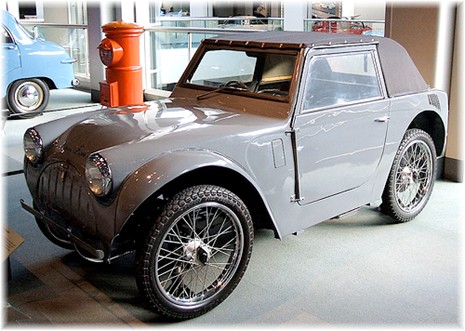Flying Feathers
By AutoPuzzles Feature Writer Alec Wolf

In
the initial, joyful period after the Second World War, there emerged a hard
economic crisis, when the theretofore flourishing defense industries lost their
orders. The lack of raw material and gasoline added to those woes, both the
winning and losing countries felt the effect. It’s not a coincidence that the
short heyday of the micro cars began at the end of the 1940’s in
Datsun
had returned to automobile manufacturing in 1947 with the Austin Seven-based DA
model, which had been in production before the war as the Model 17. The little
car – which was built with a 722 ccm, 17 HP inline four cylinder engine – was
followed two years later by the more modern body, resembling a Crosley. These
featured an improved
However,
Katayama wanted to build an even less expensive car. In this, he was not
supported by the management of Datsun. So, he and his friend, engineer
Ryuichi Tomiya, began the development of a small car on the second floor of a
The
first prototype of the new small car was introduced in 1951, called the Datsun
“Flying Feather”. Katayama explained the origin of the Flying Feather name: in
the forties, he saw flying gulls above the
In
1953, Mr. K made a made a tactical error in his Datsun carrer. He brought in
food for striking employees who had been holed up in the factory for five
months. This was enough to drive Datsun management to bounce him out of his
office. Katayama decided to complete the Flying Feather with Tomiya, without the
help of Datsun.
Fortunately, the Japanese Ministry of International Trade and Industry (MITI) supported the construction of the promising little car. For 1953, the second prototype was ready with the final, 12.5 HP, 350 cc V2 engine. It was fitted with four-wheel independent suspension, which promised great drivability for the diminutive 425 kg car. The finalized production model was introduced in the first Tokyo Autoshow in 1954. The production of the Flying Feather was assumed by the Suminoe Engineering Works Ltd., which was a manufacturer of interior components for Datsun.

But
the expected success did not materialize. The governmental support of MITI came
to an end, and as a result, the cost of production was greater than
estimated. Also, the expected
demand did not develop. In the mid-fifties, the Japanese people wanted larger,
less austere cars. Through 1955, only 150 – 200 Flying Feathers were produced by
Suminoe. Production ended, and Katayama returned to Datsun, where he was
received with open arms. He got a new job, assuming the responsibility for
enhancing the image of Datsun. This time around, Mr. K pushed the concept
of sports cars. Katayama spearheaded the development of the Fairlady Z
Convertible, and the enhancing the performance of the old, Austin-based
engines.
Katayama
encouraged management to launch a team for the 10,000 mile Mobilgas rally in
Before
Katayama’s American tour in 1960 – a research mission to prepare Datsun for the
overseas markets – he dusted off the concept of his first microcar, and together
with Tomiya, rebuilt one Flying Feather with a new, streamlined, aluminum body.
The old engine was replaced with a new Subaru 360 unit, which increased greatly
the original’s barely 60 km/h top speed.

Flying Feather II
Later,
exciting chapters of Mr. K’s story, including the Datsun 240 Z, designed by
Albrecht Goertz, and the Datsun 510, would follow in the sixties, and are
well-documented. But maybe the most important chapter in the life of a 100 years
old car-guru was the chapter, when he conceived and built the Flying Feather
“people’s car”. In that chapter, his approach to building a car most closely
resembled his personal support for the working class and unions.
